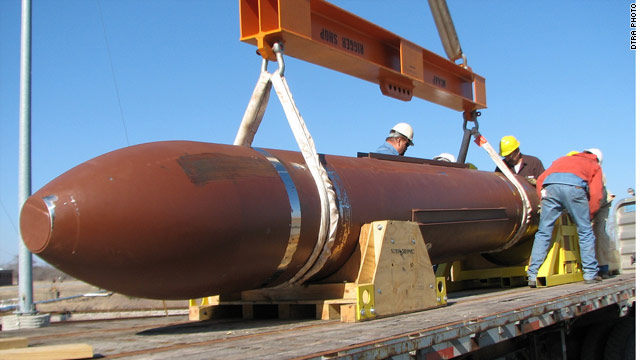
They had casings of high grade steel, much stronger than the typical World War II bomb so that they would survive hitting a hardened surface, or penetrate deep into the ground. Using the same principle as a spinning top, this enabled them to resist being deflected, thereby improving accuracy. The tails were designed with offset fins causing the bombs to spin as they fell. The designs were very aerodynamic, allowing them to exceed the speed of sound as they fell from 22,000 ft (6,700 m). These were "Earthquake" bombs-a concept he had first proposed in 1939. In World War II, the British designer Barnes Wallis, already famous for inventing the bouncing bomb, designed two bombs that would become the conceptual predecessors of modern bunker busters: the five tonne Tallboy and the ten tonne Grand Slam. The bomb was one of a number dropped on the bunker during post-war testing Diagram of a roof penetration produced by a Disney bomb striking the German, Valentin U-boat pen. Note the figure standing on the pile of rubble. United Kingdom A U-Boat pen after being hit by a Grand Slam.
#BUNKER BUSTER MARIUPOL SERIES#
In World War II the Luftwaffe developed a series of unguided rocket-propelled armor-piercing bombs for use against shipping and fortifications. Aircraft delivered bombs World War II Germany

They were tested in 19 against the Belgian Fort d'Aubin-Neufchâteau. Röchling shells were bunker-busting artillery shells, developed by the German engineer August Cönders, based on the theory of increasing sectional density to improve penetration.

( Learn how and when to remove this template message)Ī bunker buster is a type of munition that is designed to penetrate hardened targets or targets buried deep underground, such as military bunkers.Īrmor piercing shells Germany

( January 2023) ( Learn how and when to remove this template message) Please improve this article by removing excessive or inappropriate external links, and converting useful links where appropriate into footnote references. This article's use of external links may not follow Wikipedia's policies or guidelines.


 0 kommentar(er)
0 kommentar(er)
